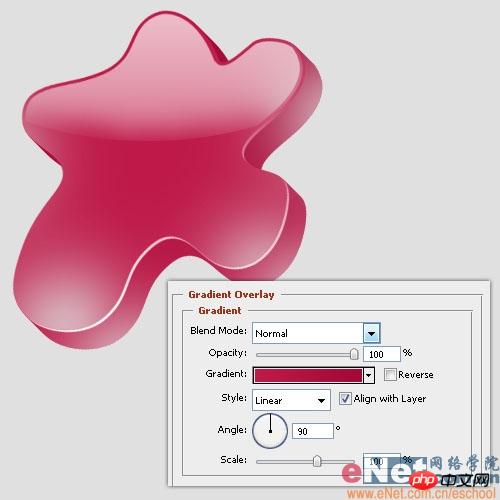PS创建一个漂亮的3D质感按钮
以前我们制作3D按钮往往需要借助3DMAX,和其他3D软件。对于不熟悉此类软件朋友要想制作3D按钮往往成了一个难题。但是没关系只要你略懂PHOTOSHOP,就能够做出一个不逊于3D软件的质感不错的水晶按钮,在今天的教程中你将学会用PS来创建一个漂亮的3D质感按钮,这种方法还使用于制作网站LOGO,UI等等……
先看一下最终效果:  下面我们开始制作
下面我们开始制作
1.首先,在PS中建立一个500×500像素大小的新文件,这个大小通常比较适合创建按钮。下面将你的背景层的颜色填充为#e0e0e0。 
2.现在建立一个新图层,加入任何一个所喜欢的形状,这里我暂且用自定形状工具中的形状来做个实例。形状的颜色我用#be1947,并将该层至于最顶层。  3.下面,用透视变换工具(编辑-变换-透视)将形状向右边拉伸一些。然后,在用变换工具(编辑-自由变换)将形状向左旋转大约15度。
3.下面,用透视变换工具(编辑-变换-透视)将形状向右边拉伸一些。然后,在用变换工具(编辑-自由变换)将形状向左旋转大约15度。 
4.现在,我们来制作形状的立体效果。首先选中形状图层并按住SHIFT和ALT键盘,然后用右手同时按下下方向键和右方向键按图层就被自动复制了一层。再重复以上步骤,当达到了一定的厚度即可停止。然后将除最顶层以外的所有的图层合并。现在在最顶层上按住CTRL键点击该图层载入其选区用#a00330颜色代码进行填充。并双击此图层重命名为“bottom”。  5.接下来,复制最顶层并把得到的复制层移动到3D形状层和最顶层之间,然后同时按下下,右2个方向键2次。移动完以后双击此图层加入渐变叠加图层样式如下所示:
5.接下来,复制最顶层并把得到的复制层移动到3D形状层和最顶层之间,然后同时按下下,右2个方向键2次。移动完以后双击此图层加入渐变叠加图层样式如下所示: 
6.在最顶层建立一个新图层,命名为“top highlights”。然后按住CTRL点击载入上层形状层的选区,用画笔工具,设置一个较软的画笔,大小约为200像素。在“top highlights”上加入高光如下所示:  7.同上面步骤一样,在3D形状层上建立一个新图层,在用画笔来创建3D形状层上的高光。然后将2个创建按出来的高光图层的不透明度设置为60-70之间,如图所示:
7.同上面步骤一样,在3D形状层上建立一个新图层,在用画笔来创建3D形状层上的高光。然后将2个创建按出来的高光图层的不透明度设置为60-70之间,如图所示: 
8.继续在最顶上再建立一个新图层,命名为“shine”。然后用椭圆选框工具建立一个椭圆选区并用白色填充如下所示:  9.选择原始形状层,按CTRL点击此层载入其选择区然后执行选择-修改-收缩,设置数值为3像素。然后在执行选择-反选-删除命令,结果如下所示:
9.选择原始形状层,按CTRL点击此层载入其选择区然后执行选择-修改-收缩,设置数值为3像素。然后在执行选择-反选-删除命令,结果如下所示: 
10.现在仍然选中“shine”层,用橡皮工具将橡皮的画笔笔触设置的软一些。擦出“shine”层边缘的一些部分,如下所示:  11.双击“shine”层设置图层样式,如下所示:
11.双击“shine”层设置图层样式,如下所示: 
12.下面加入最后的一个步骤,改变原始形状层和3D层的颜色,分别双击以上2个图层加入渐变叠加图层样式。  最终完成!你可以吧这个方法用在许多不同形状的物体上,来为它们制作亮丽的光线和效果。
最终完成!你可以吧这个方法用在许多不同形状的物体上,来为它们制作亮丽的光线和效果。 

Hot AI Tools

Undresser.AI Undress
AI-powered app for creating realistic nude photos

AI Clothes Remover
Online AI tool for removing clothes from photos.

Undress AI Tool
Undress images for free

Clothoff.io
AI clothes remover

Video Face Swap
Swap faces in any video effortlessly with our completely free AI face swap tool!

Hot Article

Hot Tools

Notepad++7.3.1
Easy-to-use and free code editor

SublimeText3 Chinese version
Chinese version, very easy to use

Zend Studio 13.0.1
Powerful PHP integrated development environment

Dreamweaver CS6
Visual web development tools

SublimeText3 Mac version
God-level code editing software (SublimeText3)

Hot Topics
 How to use the chrono library in C?
Apr 28, 2025 pm 10:18 PM
How to use the chrono library in C?
Apr 28, 2025 pm 10:18 PM
Using the chrono library in C can allow you to control time and time intervals more accurately. Let's explore the charm of this library. C's chrono library is part of the standard library, which provides a modern way to deal with time and time intervals. For programmers who have suffered from time.h and ctime, chrono is undoubtedly a boon. It not only improves the readability and maintainability of the code, but also provides higher accuracy and flexibility. Let's start with the basics. The chrono library mainly includes the following key components: std::chrono::system_clock: represents the system clock, used to obtain the current time. std::chron
 How to measure thread performance in C?
Apr 28, 2025 pm 10:21 PM
How to measure thread performance in C?
Apr 28, 2025 pm 10:21 PM
Measuring thread performance in C can use the timing tools, performance analysis tools, and custom timers in the standard library. 1. Use the library to measure execution time. 2. Use gprof for performance analysis. The steps include adding the -pg option during compilation, running the program to generate a gmon.out file, and generating a performance report. 3. Use Valgrind's Callgrind module to perform more detailed analysis. The steps include running the program to generate the callgrind.out file and viewing the results using kcachegrind. 4. Custom timers can flexibly measure the execution time of a specific code segment. These methods help to fully understand thread performance and optimize code.
 How to optimize code
Apr 28, 2025 pm 10:27 PM
How to optimize code
Apr 28, 2025 pm 10:27 PM
C code optimization can be achieved through the following strategies: 1. Manually manage memory for optimization use; 2. Write code that complies with compiler optimization rules; 3. Select appropriate algorithms and data structures; 4. Use inline functions to reduce call overhead; 5. Apply template metaprogramming to optimize at compile time; 6. Avoid unnecessary copying, use moving semantics and reference parameters; 7. Use const correctly to help compiler optimization; 8. Select appropriate data structures, such as std::vector.
 How to use string streams in C?
Apr 28, 2025 pm 09:12 PM
How to use string streams in C?
Apr 28, 2025 pm 09:12 PM
The main steps and precautions for using string streams in C are as follows: 1. Create an output string stream and convert data, such as converting integers into strings. 2. Apply to serialization of complex data structures, such as converting vector into strings. 3. Pay attention to performance issues and avoid frequent use of string streams when processing large amounts of data. You can consider using the append method of std::string. 4. Pay attention to memory management and avoid frequent creation and destruction of string stream objects. You can reuse or use std::stringstream.
 What is static analysis in C?
Apr 28, 2025 pm 09:09 PM
What is static analysis in C?
Apr 28, 2025 pm 09:09 PM
The application of static analysis in C mainly includes discovering memory management problems, checking code logic errors, and improving code security. 1) Static analysis can identify problems such as memory leaks, double releases, and uninitialized pointers. 2) It can detect unused variables, dead code and logical contradictions. 3) Static analysis tools such as Coverity can detect buffer overflow, integer overflow and unsafe API calls to improve code security.
 How to understand DMA operations in C?
Apr 28, 2025 pm 10:09 PM
How to understand DMA operations in C?
Apr 28, 2025 pm 10:09 PM
DMA in C refers to DirectMemoryAccess, a direct memory access technology, allowing hardware devices to directly transmit data to memory without CPU intervention. 1) DMA operation is highly dependent on hardware devices and drivers, and the implementation method varies from system to system. 2) Direct access to memory may bring security risks, and the correctness and security of the code must be ensured. 3) DMA can improve performance, but improper use may lead to degradation of system performance. Through practice and learning, we can master the skills of using DMA and maximize its effectiveness in scenarios such as high-speed data transmission and real-time signal processing.
 What is real-time operating system programming in C?
Apr 28, 2025 pm 10:15 PM
What is real-time operating system programming in C?
Apr 28, 2025 pm 10:15 PM
C performs well in real-time operating system (RTOS) programming, providing efficient execution efficiency and precise time management. 1) C Meet the needs of RTOS through direct operation of hardware resources and efficient memory management. 2) Using object-oriented features, C can design a flexible task scheduling system. 3) C supports efficient interrupt processing, but dynamic memory allocation and exception processing must be avoided to ensure real-time. 4) Template programming and inline functions help in performance optimization. 5) In practical applications, C can be used to implement an efficient logging system.
 How to implement loosely coupled design in C?
Apr 28, 2025 pm 09:42 PM
How to implement loosely coupled design in C?
Apr 28, 2025 pm 09:42 PM
To implement loose coupling design in C, you can use the following methods: 1. Use interfaces, such as defining the Logger interface and implementing FileLogger and ConsoleLogger; 2. Dependency injection, such as the DataAccess class receives Database pointers through the constructor; 3. Observer mode, such as the Subject class notifies ConcreteObserver and AnotherObserver. Through these technologies, dependencies between modules can be reduced and code maintainability and flexibility can be improved.






